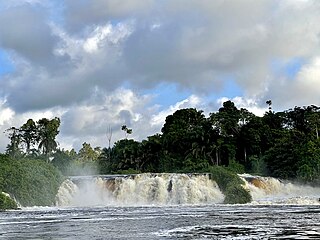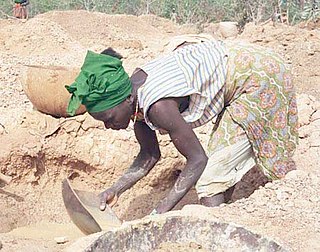
Transport in Guinea is composed by a variety of systems that people in the country use to get around as well as to and from domestic and international destinations. The railway from Conakry to Kankan ceased operating in the mid-1980s. Most vehicles in Guinea are 20+ years old, and cabs are any four-door vehicle which the owner has designated as being for hire. Domestic air services are intermittent. Conakry International Airport is the largest airport in the country, with flights to other cities in Africa as well as to Europe.
Forécariah is a sub-prefecture and town located in western Guinea. It is the capital of Forécariah Prefecture.
Mbalam is a place in Cameroon near the southern border with the Republic of the Congo where there are significant deposits of iron ore. The mining company is Sundance Resources Limited.
Titanium mining in Africa has been beset by environmental problems due to the polluting nature of processing rutile, a principal titanium ore. Titanium production in Africa includes the following principal countries and companies.

Lolabé is a small coastal town in Cameroon. It lies on the Atlantic Ocean, about halfway between Kribi and the border with Equatorial Guinea.

Simandou is a 110-kilometre-long (68 mi) range of hills located in the Nzérékoré and Kankan regions of southeastern Guinea, in the country's mountainous, forested Guinée Forestière region. At the southern end of the range the site of a large iron ore deposit is currently being developed.
Matakong is an island just off the coast of Guinea between the capital Conakry and the Sierra Leone border.
Railway stations in the Republic of the Congo (Congo) include:

The list of railway stations in Cameroon includes:
Railway stations in Guinea include:
Kalia is one of two towns in Guinea with this name. This is the one in Faranah Prefecture. It is east of the capital Conakry near Faranah and near to the border with Sierra Leone.
Mayoko is a town in the Mayoko District, Niari Department, east of the Republic of the Congo.
Kumba Iron Ore is an iron-ore mining company in South Africa. It is the fifth largest iron-ore producer in the world and the largest in Africa.
The Monts Avima are a mountain range in the Republic of the Congo near Gabon border to the west, and the Cameroon border to the north. The highest peak is the Mt. Avima in a 40 km west to east oriented ridge with several other top points which exceed 900 m above sea level. These mounts have a significant deposit of iron ore and few small gold placer deposits. The mountain is covered by rain-forest. The forest is inhabited by a small local tribe of native people who live on from hunting and from alluvial gold mining. Between March and September 2009 it was an access road built from Cameroon border to Mt. Avima for a mining exploration program arriving to the top of the mountain. After the exploration program, the road was covered by the rain forest blocking the access by vehicles to the mountain. Due to the significant quantities and qualities of iron ore discovered, it is expected that mining activities will start in the future.

Sundance Resources Limited is an Australian mining company, based in Perth, Western Australia, whose main assets are iron ore leases in Cameroon near Mbalam, and across the border in the Republic of Congo. Following the loss of the Congo mining licence in 2020, Sundance Resources delisted from the Australian Securities Exchange and sued Congo to acquire $8.76 billion in compensation.

Railways in Liberia comprised two lines from the port of Monrovia in the northeast, and one line from the port of Buchanan in the centre. The lines were built principally to transport iron ore. By 2010, only the Bong mine railway was operational but the Lamco Railway was rebuilt by Arcelor Mittal and put back into service in 2011 as far as Tokadeh, Nimba County, allowing export of iron ore from the company's mine on the Guinean border via the Port of Buchanan.

Oil and gas dominate the extraction industries of the Republic of the Congo, also referred to as Congo-Brazzaville. The petroleum industry accounted for 89% of the country’s exports in 2010. Among African crude oil producers in 2010, The Congo ranked seventh. Nearly all of the country's hydrocarbons were produced off-shore. The minerals sector is administered by the Department of Mines and Geology. Presently no major mining activities are underway, although there are some small-scale domestic operations. However, the country does have numerous large-scale undeveloped resources. The country has recently attracted a strong influx of international companies seeking to tap into the vast mineral wealth.
The Simandou mine is a large iron ore mine which is tied to one of the biggest mining corruptions in modern history. The mine is located in the Simandou mountain range of southern Guinea's Nzérékoré Region. Simandou represents one of the largest iron ore reserves in the world, having estimated reserves of 2.4 billion tonnes of ore grading 65% iron metal.

The mining industry of Guinea was developed during colonial rule. The minerals extracted consisted of iron, gold, diamond, and bauxite. Guinea ranks first in the world in bauxite reserves and 6th in the extraction of high-grade bauxite, the aluminium ore. The mining industry and exports of mining products accounted for 17% of Guinea's gross domestic product (GDP) in 2010. Mining accounts for over 50% of its exports. The country accounts for 94% of Africa's mining production of bauxite. The large mineral reserve, which has mostly remained untapped, is of immense interest for international firms.

The mining industry of Liberia has witnessed a revival after the civil war which ended in 2003. Gold, diamonds, and iron ore form the core minerals of the mining sector with a new Mineral Development Policy and Mining Code being put in place to attract foreign investments. In 2013, the mineral sector accounted for 11% of GDP in the country and the World Bank projected a further increase in the sector by 2017.








